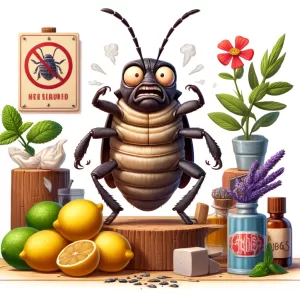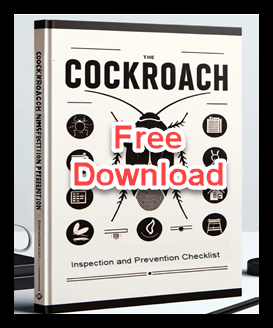What Smell do Palmetto Bugs Hate?
 Palmetto bugs, also known as American cockroaches, are unwelcome visitors in many homes. One of the most effective and natural ways to repel these pests is by using scents they find offensive. In this article, we’ll explore the smells that palmetto bugs hate and how you can use these to keep them out of your home.
Palmetto bugs, also known as American cockroaches, are unwelcome visitors in many homes. One of the most effective and natural ways to repel these pests is by using scents they find offensive. In this article, we’ll explore the smells that palmetto bugs hate and how you can use these to keep them out of your home.
Why Smells Work Against Palmetto Bugs
Palmetto bugs rely heavily on their sense of smell to find food and navigate their environment. Strong, unpleasant odors can disrupt their ability to detect food and communicate, driving them away from treated areas.
Smells Palmetto Bugs Hate
- Citrus
- Description: Palmetto bugs detest the fresh, sharp scent of citrus fruits like lemons, oranges, and grapefruits.
- Usage: Use citrus essential oils or the peels of citrus fruits. Place peels in areas where palmetto bugs are likely to enter, or create a spray using citrus oil mixed with water.
- Peppermint
- Description: The strong, minty aroma of peppermint is highly repellent to palmetto bugs.
- Usage: Place peppermint oil-soaked cotton balls in strategic locations, or make a spray by mixing peppermint oil with water.
- Lavender
- Description: Lavender’s pleasant scent to humans is disliked by palmetto bugs.
- Usage: Use lavender essential oil in a diffuser, or place dried lavender sachets in areas prone to infestation.
- Eucalyptus
- Description: The medicinal, menthol-like scent of eucalyptus is another effective repellent.
- Usage: Apply eucalyptus oil to entry points, or use eucalyptus leaves in problem areas.
- Tea Tree Oil
- Description: Tea tree oil has a potent, antiseptic smell that palmetto bugs avoid.
- Usage: Mix tea tree oil with water to create a spray, and apply it around entry points and hiding spots.
- Cedarwood
- Description: The woody scent of cedar is known to repel a variety of insects, including palmetto bugs.
- Usage: Use cedarwood essential oil, or place cedar blocks and chips in closets and other infested areas.
How to Use These Smells to Repel Palmetto Bugs
- Essential Oil Sprays
- Recipe: Mix 10-15 drops of your chosen essential oil with one cup of water. Pour the mixture into a spray bottle and shake well.
- Application: Spray around doorways, windowsills, baseboards, and other entry points.
- Cotton Balls
- Method: Soak cotton balls in essential oil and place them in areas where palmetto bugs are likely to enter or hide.
- Replacement: Replace the cotton balls every few days to maintain a strong scent.
- Peels and Herbs
- Citrus Peels: Scatter fresh citrus peels in cabinets, under sinks, and near entry points.
- Dried Herbs: Use sachets filled with dried lavender or eucalyptus leaves in closets, drawers, and other storage areas.
Additional Tips for Repelling Palmetto Bugs
- Maintain Cleanliness
- Sanitation: Keep your home clean, especially the kitchen and bathroom areas. Regularly remove garbage and avoid leaving food out.
- Seal Entry Points
- Caulking: Seal cracks and gaps in walls, floors, and around windows and doors to prevent palmetto bugs from entering.
- Reduce Moisture
- Fix Leaks: Repair any leaks and use dehumidifiers in damp areas to make your home less attractive to palmetto bugs.
Using scents that palmetto bugs hate is a natural and effective way to keep these pests at bay. By incorporating essential oils, citrus peels, and dried herbs into your pest control routine, you can create an environment that is uninviting to palmetto bugs. Combine these methods with proper sanitation, sealing entry points, and reducing moisture for the best results.
Take action today by using these natural scents to repel palmetto bugs and maintain a clean, bug-free home. If you find that your efforts are not enough, consider seeking professional pest control services for more comprehensive solutions.
- The Life Span of a Cockroach
- Do Cockroaches Eat Clothes?
- Do Cockroaches Have Teeth?
- Shrimps and Cockroaches
- Will Sleeping with the Light On Keep Cockroaches Away?
- How to get roaches out of your car overnight
- Do Cockroaches Feel Pain?
- How Many Legs Do Cockroaches Have?
- Comparing Cockroach Eggs Size for Different Types of Cockroaches
- Identifying a Cockroach Bite on the Lips or Face
- Black Water Bug Identification and Control
- Why Do Water Bugs Come Out At Night?
- What Does Roach Rash Look Like?
- Can Cockroaches Bite Your Eyelid?
- Can Cockroaches Live in Your Balls?
- How did cockroaches get their name?
- Why Do Cockroaches Shed Their Skin?
- What Smell do Palmetto Bugs Hate?
- Baby Palmetto Bug: Identification and Control
- Cockroach Eggs vs Poop: How to Tell the Difference
- How to Get Rid of Water Bugs
- How Long Can a Cockroach Live Without Air?
- The Lifecycle of the German Cockroach: From Egg to Adult
- Do Mice Eat Roaches
- Wood Roach vs. Cockroach

